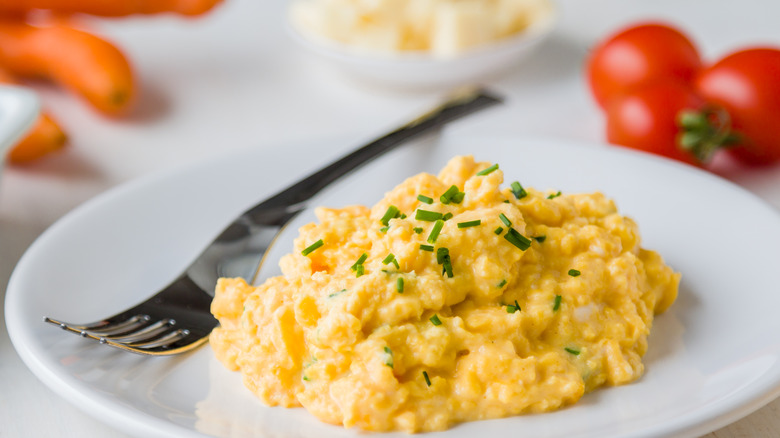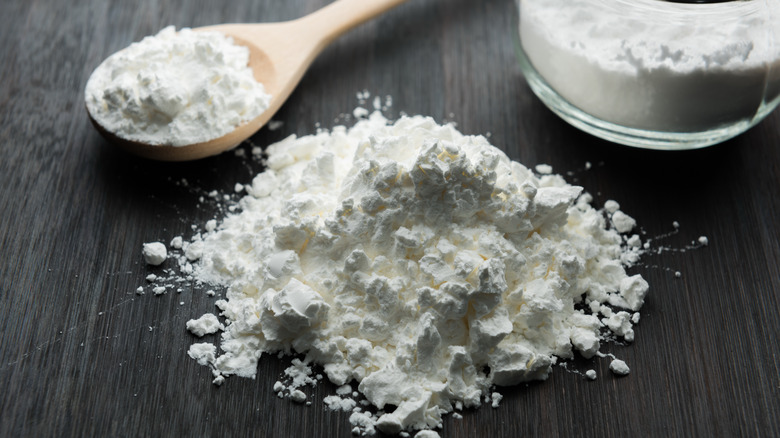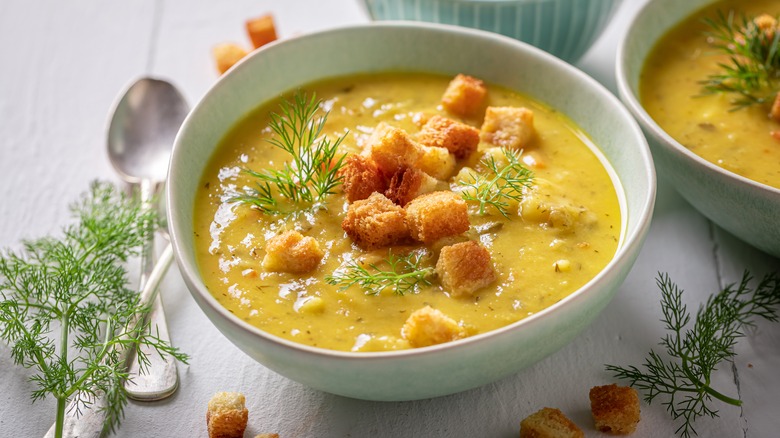The Unexpected Pantry Ingredient That Prevents Dry Scrambled Eggs
Somewhere in the world, at this very moment, someone is discovering a new way to cook an egg, either accidentally or by design. Whether or not you believe the culinary lore that ascribes the folds in a chef's toque with the number of ways they can prepare an egg (per Bon Appétit), there's cold-hard evidence that proves the four basic methods of egg cookery (frying, boiling, scrambling, and baking) give way to at least 101 variations. As of this writing, the revenue-based market size of the chicken egg industry in the U.S. alone exceeds 10 billion, per IBISWorld data.
Eating eggs for every meal (hopefully with some contrast in form) is perfectly acceptable, but the ingredient reigns supreme on breakfast plates. We happen to love a scramble, which, again, is its own broad category with ample room for experimentation. Tips and tricks for restaurant-quality scrambles abound, ranging from simple (like Samin Nosrat's method, which calls for a few drops of lemon juice according to The Washington Post) to complicated (like Chef Daniel Patterson's high-octane method that involves a whirlpool of boiling water).
In his New York Times recipe for "Extra Creamy Scrambled Eggs," J. Kenji Lopez-Alt leans into the former camp by turning to an unexpected pantry staple.
The secret's in the starch
When J. Kenji Lopez-Alt is making scrambled eggs, he reaches for powdered starch. In a recent recipe featured in his New York Times column (which he's "non-jokingly considering" making an "all-egg-all-time column," per a post on his Instagram), he calls for a splash of starch slurry (starch mixed with water) that yields a "tender and moist" bite. He prefers tapioca or potato starch for optimal tenderness but says cornstarch will work fine in a pinch.
The method is inspired by a recipe from Lady & Pups food blogger and Food52 contributor Mandy Lee, which assures that adding a little starch to your egg mixture helps "bind with the protein even if cooked over high heat," safeguarding against eggs that are either too watery or too tough. "But better yet, it also creates a creamy and custardy texture with the bits of beaten eggs that aren't completely cooked through," writes Lee.
Lopez-Alt sets his skillet over medium-high and drops in the mixture when the pan is hot enough to dissolve a tablespoon or water, "leaving behind only a few small droplets." While the starch provides some wiggle room, the cooking process still happens faster than you'd think. He lets them go for one to two minutes, agitating them when he wants "finer, softer curds" and leaving them be when he wants larger pieces.
The many uses of starch
Just like the pasta water that helps turn a watery sauce into a rich, glossy emulsion, extra starch can add body to things like soups, stews, custards, and pie fillings. Kitchen Stories breaks down the ingredient's many talents, noting that, in addition to its standard use as a thickening agent, it can also be used to "tighten up" the crispy exterior of fried chicken, tempura, and other such dishes. Unlike flour, another popular thickening agent famously used in roux, starch typically doesn't contain gluten, making it perfect for the gluten-sensitive diners at your table.
Starch is particularly prevalent in Chinese cooking. The Woks of Life sings the praises of cornstarch, also known as corn flour. From its place in meat marinades that create a "velvety texture" after stir-frying to deep-fry dredges to chewy baked goods, it's no wonder cornstarch is featured on the blog's roundup of essential Chinese pantry staples (via The Woks of Life).


